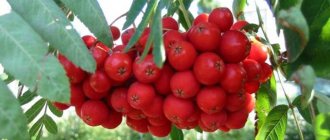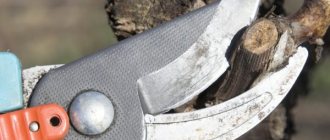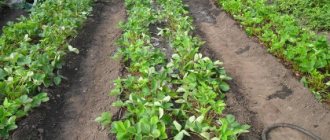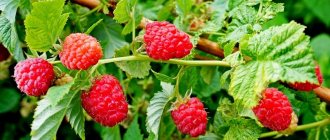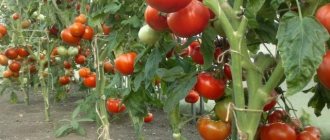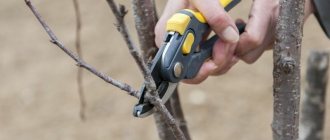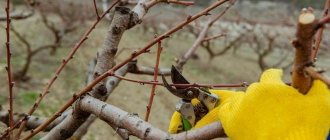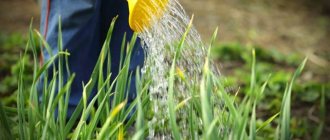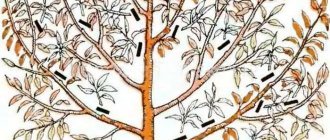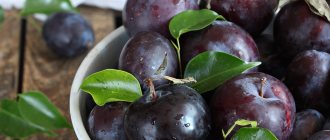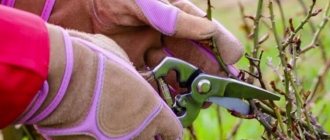Why prune a cherry tree in spring?
Good fertilizers and timely watering are not the guarantee of a rich harvest. The plant needs to be looked after by pruning it. This tree is one of the first to please us with beautiful flowering, so we prune it in the spring.
Cherry pruning helps solve the following problems:
- Correct formation of the crown and size of the tree. Cherries are often used to decorate a home’s area or garden (dwarf species are especially popular), so in the spring it’s time to give shape to the future blossoming cherry, paying special attention to symmetry.
- Shoots from last year only prevent the plant from reproducing further, so they are removed for a rich harvest. The old shoot takes away nutrients and prevents new ones from developing.
- The mighty crown of a tree is a decoration for the garden, but such a crown takes away all the useful substances and elements from the berries. So, for the sake of sweet and large fruits, you will have to sacrifice the appearance of the cherry.
- Plants tend to age and produce poor harvests. Cutting off old parts literally rejuvenates your tree; the main thing is to cut off shoots that are not too short and pay attention to their external condition.
- Pests and birds also don’t mind eating cherries, so before the start of the new season, we cut off the nibbled and infected parts of the plant.
- Without a thick crown and powerful branches, the berries receive more sun and heat, which means they will be tastier and juicier, and also, the sun's rays are a good prevention of mold and rotting processes.
Why do we love cherries so much? Firstly, sweet and sour juicy berries ripen quickly and delight us with their taste already in the middle of summer. Secondly, the bright red color stands out from others and decorates the garden in an interesting way. And during flowering, white flowers add tenderness and create a spring mood. But without proper care, the life of this plant is short-lived - every year it produces less and less harvest. Both pests and improper care contribute to this. But the gardener can correct this by timely pruning the tree.
Step-by-step instructions for pruning cherry trees in spring
The pruning order is determined by the type of cherry and its age. For young, mature and aged trees there is a separate pruning technique. There is also a separate procedure for creating crowns for bush-like and tree-like cherries.
young tree
Young cherry trees are pruned immediately after planting the tree. The purpose of pruning is to form the correct crown and promote root engraftment. The procedure for pruning a young seedling:
- Determined by the purpose of the shoots. One vertical shoot will be the trunk, the rest will form the “skeleton” of the tree.
- It is required to leave 5-6 shoots growing in different directions - these will be skeletal branches. The distance between them is 10-12 cm.
- Shoots growing inside and at the wrong angle are cut off.
- Remove shoots that intersect and interfere with each other.
- Cut off the shoots at the base of the trunk.
- Cover the cuts with garden varnish.
To increase the productivity of the crop, the seedling is sequentially pruned, forming and thinning the crown, over 4-5 years.
Typically, cherry trees develop a sparsely tiered crown. This work begins from the 2nd year after planting. The cutting order is as follows:
- Second year : cut off shoots directed towards the center, dry, diseased, etc.;
- cut down branches that have grown between the skeletal branches;
- shorten the side shoots so that they are 30 cm down from the top;
- branches thickening the crown are removed into a ring - to the base.
- shoots that have grown 60 cm or more are shortened by 9-10 cm;
- remove branches that thicken the crown and look inward;
By the fifth year, the tree should have about 15 frame branches. On both sides of the skeletal branches are semi-skeletal branches.
How to trim a young tree can be seen in the video below:
fruit tree
Pruning fruiting cherries:
- Having sawed off and cut off the branches that thicken the crown, only horizontal branches are left.
- Branches that interfere with the proper growth of the main branches are trimmed.
- If necessary, reduce the height of the main trunk - if it is more than 20 cm higher than the skeletal branches.
- Annual growth is cut to a minimum length.
- Skeletal branches are shortened to the point where new lateral branches have stopped growing. In the future, rejuvenating pruning is performed every 2-3 years.
The technology for pruning cherries is determined largely by its varietal. The crop can look like a tree or a bush; each option has its own pruning order.
old cherry
Rejuvenation is necessary for cherries older than 10-12 years. “Rejuvenating” pruning extends the life of the tree and its fruiting. It is carried out in parallel with sanitary pruning. If the growth of shoots per year is less than 15-20 cm, and the yield has fallen, it is time to carry out anti-aging pruning. The essence of the latter is the replacement of outdated, “empty” branches. The main thing is not to rush, to go towards the goal gradually.
If the cherry tree has root shoots, the old trunk is cut down, replacing it with a basal shoot.
There are several options for restoring the productivity of cherries:
- Rejuvenating an old cherry tree by trimming the top:
- The crown is sawed off at a height of 2.5-3 m. This pruning activates the underlying lateral buds - new lateral shoots will grow from them.
- When new branches appear, those that are most well located are left. The others are removed.
- During the time that new branches grow, 1-2 old branches are removed every spring.
- Creating a new skeleton from tops - branches located perpendicular to the surface:
- To stimulate the appearance of tops, shoots in the crown are cut off so that stumps remain.
- The tops are tilted at a certain angle, tied to stakes.
- Method for shortening skeletal branches. On an old skeleton, the branches are shortened to lateral branches directed upward. There are two options for anti-aging pruning by cutting off skeletal branches:
- Easy. The cut is localized where the wood is 2-3 years old - in front of the second-order branches, in the center of the frame branch.
- Deep. The skeletal branch is cut close to the trunk - where the wood is 4-5 years old.
If the plant is neglected, you cannot remove many branches at once - the cherry tree does not tolerate any pruning well. It is advisable to remove branches in stages.
You can see the pruning of an old cherry tree in the video below:
tree cherry
In tree cherries, the fruits are located on special bouquet branches. Each one has several flower buds, and at the top there is one vegetative one. Bouquet branches bear fruit for several seasons. To enhance the formation of bouquet branches, last year's shoots are shortened. In tree-like varieties, 5-6 skeletal branches must be left to form the crown.
Features of pruning tree varieties:
- If the annual growth is less than 15 cm, and the skeletal ones are exposed at the base, the tree should be rejuvenated. To do this, shoots that are 3 years old are cut off.
- If the branches dry out at the ends or entirely, it is necessary to cut off the side branches on the 5-year-old branches.
- For a tree 3-3.5 m high, growth must be limited. To do this, the skeletal branches are shortened - their tops are cut off, transferring growth to the side branches.
Bush cherry
In bush cherries, flowers and fruits are formed on the branches of the previous year. Bush-like varieties, unlike tree-like varieties, form fruits only on annual shoots. A shoot grows from the growth apical buds, which bears fruit the next year - it is called a replacement shoot. Fruits are produced mainly by the ends of annual branches. That is why young shoots are never removed from bushy varieties, so as not to be left without a harvest.
Bush varieties require powerful thinning. The plant is prone to thickening, so in the spring it is important to thin it out well, otherwise the fruits will be small and the yield will be low.
Features of pruning bush cherries:
- The angle between the trunk and the lower branches is a maximum of 40 degrees. If the angle is large, the tree may subsequently fall apart.
- To create a powerful skeleton, branches that compete with the main trunk are pruned.
- When forming the crown, 7-8 skeletal branches are left.
- Shoots looking down are cut down.
- At the age of two, the branches of the seedlings are cut off by 1/3, reaching 50 cm in length.
- The ends of skeletal and semi-skeletal shoots are trimmed to the dormant bud.
- Shoots are left only on plants that have grown to a height of up to 80 cm.
Features of pruning felt cherry
In felt cherries, fruiting occurs in the 2nd year of planting. The crop is characterized by high productivity. A properly pruned cherry bush has 10-12 skeletal branches. It requires regular sanitary and anti-aging pruning. It is also necessary to control the height of the felt cherry, maintaining it at a level of 2-2.5 m.
The plant tends to thicken, so pruning is done every spring. Berries are formed mainly on one-year-old shoots.
Features of pruning felt cherries:
- Annual shoots are the main source of fruit, reduced by 1/3 if they are longer than 60 cm.
- Remove all old, diseased, damaged, dry and inward branches.
- On old felt cherries, the side shoots are removed into a ring, without affecting the central part of the crown and skeletal branches.
Sanitary pruning of different types of cherries
| Type | What to do? |
| tree-like |
|
| Bushy |
|
| Felt |
|
Annual pruning
When the crown of the cherry tree is formed, the tree has gained strength and produces a harvest, it is enough to carry out sanitary and stimulating pruning once a year, in the spring. The work requires accuracy and consistency. First, mature fruit-bearing trees are serviced - they bloom first, then young seedlings are pruned.
The gardener shares his experience in pruning cherries in the following video:
Trimming order:
- Clear the crown, remove excess and thickening branches.
- Give the tree the desired shape.
How many prunings does a cherry tree need?
Cherries produce a good harvest only when pruning is done before the buds appear. But the weather makes its own adjustments to the crop care schedule: sometimes gardeners have to cut off frozen and lifeless branches after the buds open. This is done due to low temperatures outside the window. Frosts often occur at the end of April - at the beginning of May, and even snow is possible in some regions. Such temperature changes are harmful to the crop, so some even cover the roots with warm fabrics.
A few cuttings will not harm the culture at all. The shoots may never recover from winter frosts, and they will no longer be able to support the life of the cherry. Mechanical damage to branches and attacks by pests are also common. Therefore, the number of manipulations over the tree is determined only by the gardener, and if you see lifeless shoots or branches, they need to be removed.
Spring pruning of felt cherry
Pruning felt cherry trees will require more attention. After the seedling develops in the first year, you need to shorten the branches to half a meter; next year, remove about a quarter of the side branches.
Felt cherry does not produce yield, having a thick crown, so leave strong branches and shorten them to ten centimeters, all remaining shoots must be removed down to the base. When pruning, do not allow density in the center of the bush. For a bountiful harvest, cut off most of the shoots, leaving no more than 10 pieces. Preferably prune diseased or dried out branches.
Helpful tips for cutting branches
First, make sure all the tools are at hand. All the necessary tools are listed below. It is also recommended to follow these rules:
- Before cutting, determine by eye which branches the cherry tree no longer needs. The main selection criterion is damage and intertwining of branches (intertwined branches will grow incorrectly).
- There are two options for how to deal with intertwined branches: either both are cut off, or one of them is shortened.
- These plants look not only like a tree, but also like a shrub. For the second type, you need to leave at least 7 branches, from which the plant will then develop.
- If the shoot is very young (1-2 years), we shorten it by half the length.
- All shoots that are at least slightly affected by infections or pests are pruned.
- We make the dense crown sparser, and for old cherries we carry out a rejuvenating procedure (described below).
- The cut area of the tree branch should be treated with an antibacterial garden product.
Sanitary pruning
Sanitary pruning is usually carried out annually or once every 2 years.
Table: how to carry out sanitary pruning of various types of cherries
| Type of cherry | Tree-like | Bush-like | Felt |
| Events |
|
|
|
After pruning, collect debris and burn it.
Video: rules for pruning cherries
Tools available for the procedure
Tools that will be needed during the procedure:
- saw;
- garden scissors;
- garden knife;
- pruner;
- special var.
The tree is also afraid of bacteria, just like the human body. Therefore, agronomists have developed special antiseptics for plants. They need to treat not only the cutting site, but also the gardener’s tools. They not only fight infections, but also help restore the cherry to the place where it was cut. If the crop is too tall, use a stepladder to trim the upper branches.
Necessary tools for pruning
When removing shoots from cherries, you should prepare the following tools:
- saw;
- gardening scissors;
- knife;
- pruner;
- garden var.
Before the procedure, all instruments should be treated with an antiseptic. This will reduce the risk of disease and speed up healing at the cut site. Depending on the size of the plant, you may additionally need a stepladder, which can be used to shorten the upper sections of the tree.
Cherry pruning diagram step by step
The rules for pruning cherry trees depend on the age of the tree. Beginning gardeners should follow the rules described below. Failure to comply with them reduces the ability of cherries to reproduce and increases the risk of diseases and infections.
The very first pruning occurs when planting a small tree or shrub in fertile soil. Agronomists do this to form an attractive and healthy crown. Also, cutting off excess shoots is good for the roots. The general pruning scheme looks like this:
- A shoot located strictly vertically is the future trunk. Also, the frame of the plant is made up of 6 of the strongest and healthiest branches. We select the branches so that the distance between them is at least 10 cm.
- We cut off side vertical shoots or crooked branches.
- We also cut off intertwined branches and shoots, as they harm the development of other branches and prevent each other from growing.
- The shoots are also harmful to the future of the bush. It feeds on the plant, taking away nutrients.
How to prune cherries in spring for a good harvest
There are many recommendations regarding spring pruning of cherries.
Need to consider:
- weather;
- climate features;
- wood type;
- plant age.
After waiting for dry, slightly frosty weather and preparing your tools, you can begin to work. There is an expression among gardeners - cut along the “ring”. This is a compaction along the diameter of the branch almost at the very trunk. It is visible to the naked eye. You need to cut either right in the middle of the ring, or not reaching it from the barrel (the first option is preferable).
Now we have reached the main mistake of most gardeners. About half of it “cuts” at the very base, and the second part is somewhere in the middle of the branch. It is not right.
If the “ring” has not yet formed, you need to cut just above the kidney.
Plant pruning by type
The pruning procedure depends not only on the age of the crop, but also on its variety. The main types of cherries are shrubs and trees. Pruning a plant depends greatly on its species, so first understand which one is in your garden.
Cherry bush
The bushes are distinguished by a countless number of shoots. Gardeners do not cut off half of them, but only shorten the existing ones (to create a beautiful shape). Berries in shrubs appear on newly grown shoots, so there are not as many of them as on a tree; in gardens, shrubs act more as an ornamental plant.
But if you still want to reap a rich harvest from a bush, then cut off the dried and lifeless parts, leaving the young ones. Although they add lushness to the bush, they do not bring any benefit at all.
Cherry tree
The tree is the most popular cherry variety, and the main thing in its cultivation is access to sunlight. It can be obtained in several ways, both by cutting branches and by placing the tree in the garden - it should be in an open place. Also watch the buds of the tree - some branches do not produce buds at all, which means the tree does not need them.
The shoots grow constantly and can even reach 30 centimeters. But such parts will no longer be useful, so they need to be removed. The optimal length for a shoot is 7-10 cm. At this point, buds ripen and flowers bloom, which means fruits will appear.
The tree is a favorite place for pests, so it requires frequent treatment and pruning of damaged elements. Old shoots tend to dry out - the cherry no longer needs them.
Plants that have been in the garden for a long time are usually longer, but produce less and less fruit every year. Then we cut off the top part and let the tree grow in breadth, not height.
Varieties and features
All stages of pruning and crown formation must be carried out taking into account the characteristics of the type of a particular type of cherry . They are:
- tree-like - when pruning, they leave 5-6 branches as skeletal ones;
- bush-like - this type has up to 10 branches;
- coppice - they usually leave 2-3 well-developed offspring, the rest are pruned at the base or dug up for further use as seedlings.
The main task of pruning tree-type cherries is to stimulate the formation of bouquet branches. It should be uniform and ensure their long existence. With proper pruning, it is necessary to thin out perennial branches, shorten growth, trying to provide access to light to the inside of the tree crown. If this is not done, the gradual thickening of the crown will lead to the fact that the bouquet branches will begin to die off, since they will not be able to bear fruit normally in low light conditions.
With the onset of the period of full fruiting, when growth processes weaken, cherry branches may become bare, and branching deteriorates. In this case, you need to trim the branches to the nearest side branch. This simple technique enhances growth and stimulates the appearance of young shoots.
Carrying out rejuvenating pruning of tree-type cherries is necessary when observing the processes of attenuation of growth. If the crown of the tree is very thick with many bare branches, it is better to carry out rejuvenating pruning in several stages, with a frequency of 2-3 years. This is done to avoid the risk of severe gum formation. Because severe pruning will cause many wounds to the plant.
When pruning bush-type cherries, the degree of branch growth is taken into account . If growth of 30-40 cm is maintained, in this case only thinning is carried out, which should be annual. Since plants of this type form crops on growths, pruning will shorten the shoots, which will lead to a decrease in the yield of the bush, since many generative buds will be cut off.
With age, when the cherry bush weakens and reduces yield, thinning pruning can be done above the first lateral branch. If the crowns are very thick, pruning is carried out within 2-3 years.
The main mistakes when caring for a tree
It is sometimes difficult for novice agronomists to properly care for a plant, so some first samples suffer from ignorance of the rules of care. What mistakes do gardeners make when caring for trees?
- They prune the tree in summer or winter, treating with pruning shears the branches or shoots that bore the most berries or that can last for a long time.
- Shoots that have grown too much are not shortened in a timely manner.
- They do not monitor frozen branches or those that have already spent their resources. Some novice gardeners think that the thicker the tree, the more fruit it will bear, but this is not always the case.
- They do not follow sanitary rules when processing crops: they work with dirty tools, and so on.
Experts in the field of gardening and vegetable gardening say that cut branches should not be allowed to fall into humus, as diseases and infections develop in them. If you see that the cherry tree can no longer be saved and the infection has spread to the skeleton and main branches, then it should be dug up and replaced with a new seedling.
Crown formation
The best option for such a fruit tree is considered to be a sparsely tiered crown. When shaping, they use the same methods as when pruning: shortening and thinning.
The crown is formed only after the cherry tree is planted in its permanent place. Therefore, if you have buried a cherry tree for the winter, you need to trim it only after planting it in the garden.
The seedling immediately after planting in the spring forms skeletal branches of the first order. To do this, select about 5 of the strongest branches, the lowest of which should be located at a distance of about 20–30 cm above the ground. All branches growing below this threshold are removed to the ring. For skeletal branches, those that grow at an angle of 40–50 degrees from the trunk are best. Shoots growing at sharper angles may break off under the weight of the berries. Choose branches that grow at equal distances from each other and are located along the entire diameter of the trunk.
The formation of skeletal branches after planting is an important stage in caring for a seedling.
In the second year, the second-order branches are formalized. To do this, shoots growing on the upper side of the skeletal branches are removed. It is also necessary to cut off all the shoots that have grown from the trunk during the year into a ring. The central conductor (or, as it is also called, the leader) is cut so that it is 25–30 cm higher than the topmost tier of branches, no more.
When forming the crown of a seedling, branches growing inside the crown, weak twigs and small shoots on the lower part of the trunk are removed
Rejuvenating cherry pruning
Typically, cherries live for about 15 years, and during this time they bear tasty fruits. But over time, the harvest is lost, and then it is necessary to carry out anti-aging pruning (we do it for the first time after 7 years of life).
Rules for anti-aging pruning:
- We eliminate parts that prevent the plant from fully developing, even if such branches are skeletal.
- We weed the area near the tree.
- We completely cut off parts right down to the skeleton, even healthy and fertile ones. In their place, new parts will grow, more productive.
- We carry out exactly the same procedure for shrubs.
Cherry tree care after pruning
Pruning is not the only procedure that helps a tree stay healthy and produce a good harvest:
- Whitewash. The trunk of the cherry tree must be whitened and the wounds on the tree must be repaired. This helps protect it from parasites. In addition, a neatly whitewashed and well-groomed tree is a decoration of the garden.
- Feeding. Spring feeding of cherries is an important issue, since during this period the tree needs help and strength for good fruiting. The best feeding is manure mixed with ash (a bucket of manure and one kilogram of ash) and diluted in 6 buckets of water. The second feeding should be done 2 weeks after the first.
- Treatment against diseases. Various parasites wake up in the spring, so the tree may catch some disease or pest. The main diseases from which cherries suffer are moniliosis and coccomycosis. To get rid of this problem, spray using azophos and Bordeaux mixture.
Tips for caring for crops
Proper care of a crop means not only pruning it, but also watering it on a schedule, caring for the soil around the tree, and feeding it with various fertilizers.
In spring, the snow melts and the first signs of life appear around the tree. This includes the appearance of pests or weeds. They feed on substances intended for cherries, leaving them without valuable microelements. In order to save the tree, you need to plant either legumes or different varieties of lettuce nearby. Also, the most novice agronomist should pull out pest plants.
Fertilizing is an important element in growing crops. But a young and healthy tree does not need it in the first year of life. In subsequent years, fertilizing will extend the life of your plant. There are many types of fertilizers: animal manure, phosphate compounds, wood ash. There is no need to collect and store fertilizers yourself - agronomic companies produce them themselves and sell them in stores. This package comes with instructions for use. Store-bought fertilizers contain a lot of minerals.
In spring, the crop is especially lacking in nitrogen compounds, and in autumn the roots require phosphorus and potassium. But the plant does not always need fertilizers - sometimes it itself gets everything it needs from the soil. If your tree grows more than 50 cm in a season, it does not need fertilizer.
Caring for cherries is not that difficult, the main thing is to follow the basic rules. All the information on the rules for pruning cherries in the spring will be enough to grow a healthy and viable tree that will serve you for many years and will delight you with delicious fruits. The main thing is to accurately determine the age and variety of cherries, and follow the recommendations outlined above for each of them.
How to prune a fruit-bearing cherry tree
Mature trees are pruned first, because fruit-bearing stone fruit plants release their inflorescences before the vegetative buds and here the necessary formation of branches must be carried out in time. It’s not scary if this procedure drags on until the kidneys become very swollen. The main thing is that pruning the cherry tree does not begin with the appearance of greenery on the cone, which will certainly weaken the entire fruit-bearing tree. Delay in the procedure will lead to loss of nutritional reserves, as well as shortening of new shoots.
Cherry pruning table by age
| Cherry age | Young | Fruit bearing | Old |
| General characteristics | A cherry tree is considered young if it has spent a whole year in garden soil. This crop can already be pruned. Since the young tree is very fragile, it must be handled with special care. Sometimes growers remove too many shoots, which sometimes causes the plant to produce less yield or die. | A tree is considered to bear fruit after 3 years of life. | Old cherries are living out their last years in agronomists' gardens. Their yield is not high, but it can be increased by doing proper pruning and shortening too long parts. |
| Trimming Features | Rules for pruning a young plant: We form the main shoot, from which the tree will then grow (the basis of the skeleton). But the cherry tree cannot grow from just one branch, so we leave 6 other side shoots. If you see more healthy parts, you should just shorten them. We cut off parts damaged by infections or garden pests. Some parts grow not in the direction from the crop, but into it - such branches will also not bring any benefit. We treat the cutting areas with an antiseptic (special varnish or manganese mixed with water will do.) | Rules for pruning a fruit-bearing plant: We shorten long branches and shoots (young shoots will grow faster when cut. Carefully watch the tree in the process of buds appearing, flowering and fruit ripening: some branches do not provide any benefit at all. You need to get rid of them. Not only woven ones, but and the parts in contact sometimes harm each other (we prune these). To allow sunlight to enter, we make the crown sparser. It would not be a bad idea to prune some parts in the fall. At this time of year, we pay attention to damaged branches. | Rules for pruning an old plant: Shoots that have not produced berries for several years are cut off. Branches eaten by pests are also removed. In an old cherry tree, even those elements that form its skeleton are shortened. This is where you will need a saw and a stepladder. But this must be done carefully, without depriving the plant of its main fruit-bearing elements. |
Spring pruning of young cherry seedlings
The main task of pruning young cherries is to correctly form the crown. To do this, you need to use only one basic rule - leave healthy, strong branches and remove weak ones. But there are some recommendations that you should follow.
You need to start by inspecting the tree. For convenience, you can mark the branches that will be trimmed with tape or thread. This will make it more convenient to work.
Afterwards, prepare a steep solution of potassium permanganate or a solution of ash to lubricate the cut of wood. This will prevent infection from the outside. Apply with a clean brush or roller.
When to prune cherry trees
It is customary to care for cherries in the spring, when the emphasis is on giving shape to the crown, and in the fall - for the purpose of sanitary treatment and to prepare for winter. In summer, less often, but it is also recommended to remove broken branches or shoots that look inside the crown and create excess density.
The start time of spring pruning may vary depending on the climatic conditions of the region, but most often the first half of March is the right time, and in the middle zone small deviations are acceptable. It should be noted that when the tree has not begun to produce sap, has not come out of dormancy, and at the same time the buds are not yet swelling - this contributes to the rapid healing of injured areas.
We pay attention to the nighttime spring weather, where we exclude severe cold snaps and frosts, which, apart from harm, do not bring anything useful. Unwanted cracks appear, due to which you can get an infection, and healing time will take many times longer, so it is strictly not recommended to carry out procedures in winter and at the very beginning of spring
Types of Cherry Trees and Pruning Methods
Cherries are divided into two types: bushy and treelike. Depending on whether it belongs to one of these types, the shape of the plant is adjusted taking into account its characteristics. Thus, in tree-shaped cherries, skeletal-forming branches are more obvious, while in bush-shaped cherries it is not so easy to distinguish them.
Types of cherries and methods for adjusting them
bush cherry
When growing bush cherries, the main emphasis is on ensuring active shoot growth. Such cherries are capable of bearing fruit on shoots that have reached one year and are prone to thickening. Timely shortening of such shoots leads to the active development of lateral branches, while their removal threatens to dry out the entire branch.
Bush cherry is capable of bearing fruit annually on its young shoots
The main recommendations for correcting bushy cherries are as follows:
- At the moment when the ends of the branches are exposed on a mature plant, they should be cut off by about thirty percent of the total length, or even half;
- Skeletal-forming branches are shortened to buds that are at rest;
- Pruning of skeletal and semi-skeletal branches should be carried out at time intervals distant from each other, helping to improve the adaptation of the bush to external conditions and increase its fertility;
Large branches are pruned at different periods so as not to endanger the plant. Annual growths are not pruned due to the fact that there is a danger of damaging the growth buds located at the ends of the buds, which can lead to further withering of the shoots; It is allowed to shorten shoots that have reached a length of fifty centimeters - they quickly recover and subsequently begin to grow faster.
Scheme for pruning bush cherries in autumn
tree cherry
Tree cherries have pronounced skeletal branches and form fairly large trees, reaching five meters in height. Cherries of this type bear fruit both on bouquet branches and on annual shoots growing from wood.
Pruning cherry trees by year
The main recommendations for correcting tree cherry are as follows:
- The main feature of tree cherry care is the use of not only the thinning procedure, but also shortening, which is vital for the tree. Shortening is applied mainly to young trees that have not yet formed their “backbone”. They must remove forks in a timely manner, strengthen the fruiting branches and subordinate the secondary ones;
- Only long branches can be shortened, short ones remain unchanged;
In autumn, the focus is on adjusting long and strong branches. The growth of cherry trees should be controlled. When it reaches three to four meters, you need to shift the skeletal branches to another developed lateral branch.
